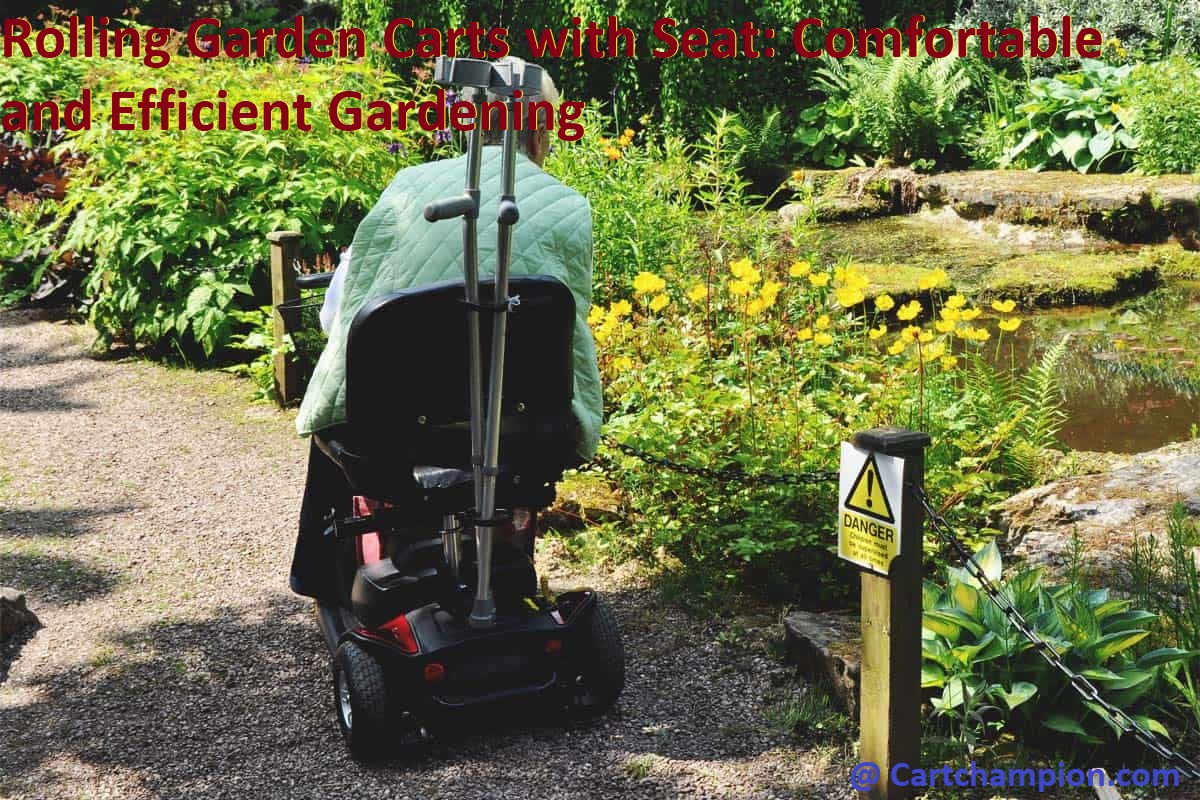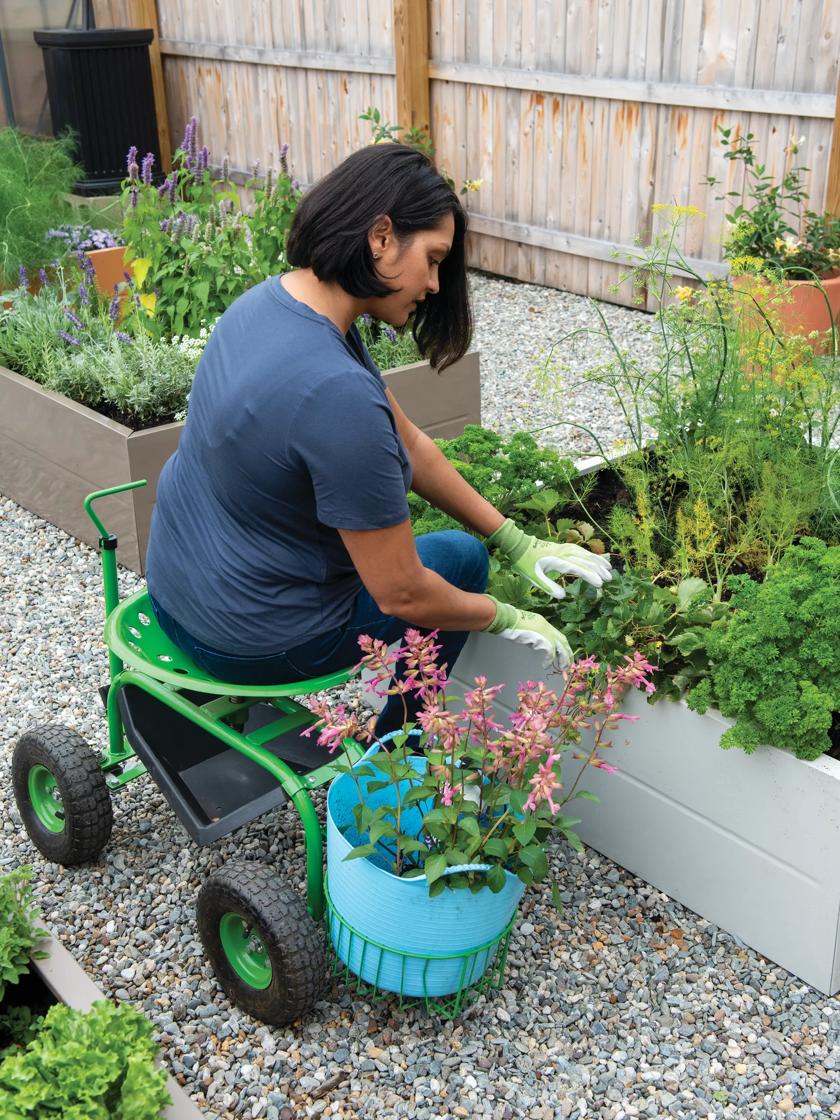Are you ready to make gardening easier and more comfortable? Rolling garden carts with seat are here to revolutionize the way you garden!
With heightened efficiency they save time and effort, allowing you to spend less energy on the tedious tasks and more time appreciating your beautiful garden. Find out why these carts are just what your garden needs.
Gardening can be an enjoyable and rewarding activity that many people enjoy. Whether you are a beginner or a seasoned pro, it is more comfortable, fun and efficient to garden with the help of a rolling garden cart with seat. Such carts not only make it easier to transport gardening tools and plants from one place to another but also provide a convenient place for you to sit down and take a break during your busy gardening day.
In this comprehensive guide, you will learn about the different types of rolling garden carts available on the market today. We will discuss each type in detail with advantages and disadvantages as well as features you must consider while buying one. We will then cover how to use such carts safely before discussing how to maintain them so they last longer and perform better over time. Finally, we will provide some tips on getting the most out of your cart when gardening.
Features of Rolling Garden Carts with Seats
Rolling garden carts with seats provide an easy and efficient way to tend to your garden. They come with a variety of useful features, including comfy seating, large cargo storage compartments, and sturdy construction. For maximum convenience, look for a rolling garden cart with adjustable handlebars and flat-free tires. Here are some other features you might like in your cart:
- Adjustable seat: To keep you comfortable while gardening, select a cart with an adjustable seat so you can find the perfect height for your body type.
- Extra storage: Many rolling garden carts feature larger cargo storage compartments that make it easy to transport items such as soil bags or seeds without having to use your hands.
- Easy maneuverability: Look for carts that come with well-designed steering systems and extra-wide wheelbases for maximum maneuverability; this adds convenience when navigating around bumpy terrain or tight corners.
- Durable frame: Go for carts made from rust-resistant materials like aluminum or powder-coated steel; these provide greater long-term durability and are more resistant to weather damage over time.
- Wheels with brakes: Some carts come equipped with foot activated parking brakes that lock the rear wheels into place when you need extra stability on uneven surfaces.

Material
The material you choose for your rolling garden cart with seat is a key factor that will have a major impact on its performance and durability. Generally speaking, there are three types of materials that you can select from: steel, plastic, and wooden products.
Steel: Steel is one of the most preferred materials when it comes to rolling garden carts with seating because it is lightweight and strong. It also resists rusting due to its powder-coated finish. However, although steel carts can be used on many surfaces, they are not suitable for very rough terrain as they might damage the wheels over time.
Plastic: Plastic carts may be less aesthetically pleasing compared to their steel counterparts but they are lightweight and more affordable. But more importantly, these carts are completely waterproof, stain-resistant and durable. This makes them ideal for those looking for an easy-to-clean option or living in areas prone to wet conditions or near the water.
Wooden: Wooden garden carts usually offer the most aesthetic appeal due their classic design. Furthermore, wood material is strong and long-lasting which means you can use your wooden cart for years no matter what conditions are like outside of potential rot caused by standing water build up around and underneath your cart’s frame if outdoors for an extended period of time in wetter climates or months with higher levels of precipitation.
Weight Capacity
When it comes to rolling garden carts with seats, the most important factor to consider is the weight capacity. It is important to note that all rolling garden carts with seats must have a weight limit, and you should always take this into consideration before making a purchase.
To determine the weight capacity of your rolling garden cart, you’ll need to think about how much weight you’re planning on carrying in your cart at any given time. Generally, manufacturers list the maximum weight limit for each cart model in their product descriptions and specifications, so it’s easy to find out exactly what your cart can handle. Some rolling garden carts can carry up to 300 pounds of storage and equipment – though you should always double-check the exact product specifications before buying.
It is also worth noting that if you plan on taking heavier items along with you on your gardening trips, your choice should be a heavy-duty cart that has sturdy wheels and an adjustable handle for easy maneuvering around tight areas while still being able to transport all of your supplies securely and safely.
Size
Selecting the right size rolling garden cart is essential for comfortable and efficient gardening. Before picking a cart, examine the width and length of your typical herb or vegetable garden rows and paths. Since there are numerous carts available in either 24-inch, 36-inch or 48-inch sizes, you’ll need to choose wisely based on your intended use. Consider how often you’ll be using the cart and if you plan on stacking multiple tools or items at once while gardening.
It’s important to also consider how much weight the cart will be carrying. A larger capacity rolling garden cart requires a broad wheelbase that can enable smooth navigation of curvy pathways. You may also want to consider adding padding so that it can provide enough comfort when seating in it, especially if you plan on doing lots of pruning around rough terrain or difficult terrain as well as seating for long hours in the garden for weeding purposes.
Wheels
Wheels are an important element of any rolling garden cart. The type you choose depends on the terrain and usage of the cart, as well as your own preferences. Some wheels swivel for easy maneuverability and others lock for stability when loaded with heavier objects.
Carts come with either plastic or rubber tires, each offering its own advantages — rubber tires provide a smoother ride, while plastic tires are lighter weight. Make sure to purchase quality wheels made from durable material because if they break it could damage your cart.
Besides large wheel sizes, there may also be options to choose from between bearing-wheels and roller-bearing-wheels which are more suited for strenuous activity and heavier loads.
Brakes
If you’re transporting tools and other items in your rolling garden cart, it’s a good idea to invest in one which includes brakes. Brakes can help you stop the cart quickly without too much effort, improving safety and stability. At the same time, however, it’s important to make sure you understand how the brakes work and how efficient they are before making a purchase.
- Brakes vs. Lockable Wheels
One option many gardeners consider when shopping for rolling carts is either E. brakes or lockable wheel casters. An E. brake is generally designed for added stability when parked but requires manual engagement (this means pushing a pedal switch or wheel with your foot). On the other hand, lockable wheel casters feature a convenient locking mechanism that requires no manual effort – simply move into position and secure with a locking pin or lever as needed. It’s important to note that most carts come standard with roller bearing wheel types; however, if you are looking for more control or maneuverability on a hard surface outdoor terrain, then wheel locking devices may be preferable.

III. Maintenance of Rolling Garden Carts with Seats
Maintaining a rolling garden cart with seat is essential to its longevity and usability. It is important to keep it clean and in good condition by following some simple steps:
- When not in use, the cart should be stored in a dry place away from extreme temperatures.
- When cleaning the fabric of the seat, make sure to use a cleaning solution that is safe for outdoor fabric and let it air-dry for a few hours before using it.
- Check for any rust spots on metal parts of the cart like tire rims, bolts, or frame tubes. If you see any rust forming, use medium-grit sandpaper to remove the rust and prime or paint over it with epoxy primer or rust-resistant paint.
- Periodically inspect all moving parts such as tires, axles, casters, and frame tubes for any wear or damage caused by regular usage or exposure to outdoor conditions. In some cases, these parts may need replacement due to wear and tear.
- Keep an eye on plastic parts and foam padding used in the garden cart’s construction- they can easily break down if not cared for properly! Evaluate whether these components need additional support from materials like vinyl cushions or PVC pipe clamps so that they do not deteriorate over time.
Following these guidelines will help keep your rolling garden cart with seat in working order for many years to come!
Regular Cleaning
To maintain the functionality of rolling garden carts with seats, regular cleaning is necessary. Make sure to clean the garden cart after each use to prevent dirt and debris from building up. Be sure to check for any loose bolts and screws, which can cause the cart to become unstable or create a hazard. Inspect the cart for any visible wear or damage, such as rust or structural weakness that can be caused by weather elements like moisture and wind.
If you have a metal garden seat cart, make sure to thoroughly clean it with an oil-based cleaner. For plastic carts, spraying them off with a hose is usually enough. You can add a bit of water and dish soap to remove any stubborn debris if needed. To protect your cart from rusting or corroding due to inclement weather conditions, you may want to apply a protective coat of car wax over the surface after cleaning.
Lubricate Moving Parts
It is important to make sure that all the moving parts, such as hinges and rollers, are lubricated. This keeps them from rusting and ensures that they will stay operational for a long time. You should use a specialized lubricant that is made for metal, or a non-toxic oil to keep all the parts working properly. You may also need to check the wheels for wear and tear periodically. Replace them if there are any signs of damage or wear. Taking these steps will ensure that your rolling garden cart with seat remains functional and comfortable for many years of gardening pleasure.
Check and Tighten Bolts and Nuts
It is essential to check and tighten all bolts and nuts regularly to ensure your rolling cart with seat is in safe condition. Feed the wires through it into the frame, periodically tightening them with a wrench or pliers. Make sure that the bolts are tightened securely so they don’t come loose, which could cause your cart to potentially tip over with you sitting on it.
Additionally, check that all axles and wheels are properly secured onto the frame, inspecting them for any loosened bolts or nuts. They should not be able to move around once they have been tightened correctly.
Furthermore, inspect that all screws are firmly secured into rails and other structural components- this will ensure the safety of you and your rolling garden cart with seat while using it in your garden.
Store in a Safe Place
When not in use, it’s important to store your rolling garden cart with seat safely. Make sure you keep it in a dry place in your garage or shed, out of the elements and away from any sources of extreme heat.
If storing indoors is not an option, consider setting the cart on blocks, so that the tires are off the ground and are also safely away from any dampness that may seep in during periods of moisture or rain. This will help to extend the life of your cart and ensure that it’s ready for use whenever you need it.
Conclusion
In conclusion, rolling garden carts with seats offer a comfortable and efficient way to enjoy gardening. With the proper selection and use of the rolling cart, you can further enjoy your outdoor activity with relaxation and ease. Depending on your needs and preferences, various sizes and features make available a variety of options to choose from when selecting just the right garden cart for you.
Finally, it is important to follow all guidelines outlined in the manual that came with you cart in order to ensure a safe experience. Enjoy your gardening journey with a rolling garden cart!
FAQ’S
What is the most effective way to grow plants?
The most effective way to grow plants depends on the specific plant’s needs but generally requires proper soil, water, sunlight, and nutrients.
What are the benefits of planting materials?
Planting materials, such as seeds or seedlings, provide the foundation for plant growth and can result in a beautiful garden or a bountiful harvest of fruits and vegetables.
How many types of soil is best for planting?
There are three main types of soil for planting: sandy, loamy, and clay soil. Loamy soil is generally considered the best type of soil for most plants.
What is quality planting material?
Quality planting material refers to seeds, seedlings, or other plant materials that are healthy, disease-free, and suited to the specific planting conditions.
What tools do you use when planting or gardening?
Tools used for planting and gardening include a shovel, rake, hoe, trowel, pruners, watering can or hose, gloves, and a wheelbarrow or garden cart.
How do you prepare an area for planting?
To prepare an area for planting, remove weeds, loosen the soil, and amend the soil with compost or fertilizer as needed. Ensure the area receives the appropriate amount of sunlight for the plants being grown.
What materials are most needed for plant growth?
Plants need soil, water, sunlight, and nutrients such as nitrogen, phosphorus, and potassium for growth.
What is the most important factor in planting?
The most important factor in planting is providing the plant with the proper growing conditions, including the right amount of sunlight, water, and nutrients.
What are the common methods of planting?
Common methods of planting include direct seeding, transplanting seedlings, and starting seeds indoors before transplanting outside.
What are the characteristics of plant materials?
The characteristics of plant materials include the plant’s size, shape, color, growth rate, and specific needs for soil, water, and sunlight.
See Also-
- Best luggage cart 2023
- Best electric push cart 2023
- Best kayak cart 2023
- Best garden cart for seniors 2023
- Best hose reel cart 2023


